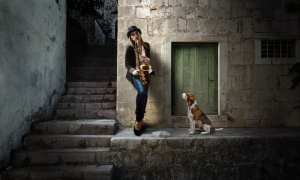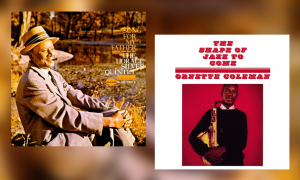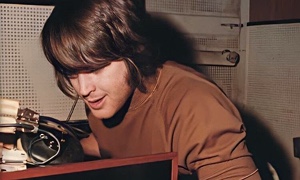Home » Jazz Articles » Building a Jazz Library » Atlantic Records: More Giant Steps: An Alternative Top 20 Albums
Atlantic Records: More Giant Steps: An Alternative Top 20 Albums

The New York Times wrote that Nesuhi Ertegun’s ‘humongous’ collection of surrealist art was ‘enough to pack the Solomon A. Guggenheim Museum from ceiling to lobby with a powerful exhibition.’ The Atlantic jazz catalogue is similarly humongous—and powerful.
Atlantic was founded in New York in 1947 by jazz and blues enthusiasts Ahmet Ertegun, the younger son of Turkey's ambassador to the US, and Herb Abramson. In 1953, Abramson left the company to complete compulsory military service, briefly returning on a freelance basis two years later. He was replaced by producer Jerry Wexler, whose interest in R&B played a significant role in Atlantic's financial success. (Wexler is reputed to have coined the term "rhythm and blues" as an alternative to "race records" while working on Billboard magazine in 1949).
In 1955, Ertegun's older brother Nesuhi Ertegun joined the label. Nesuhi's passion for jazz led to a rapid and sustained expansion of Atlantic's jazz catalogue. Nesuhi also managed the label's move away from singles and into long-playing albums. "Nesuhi opened that whole area for Atlantic," said Wexler in a 1990 interview. "Everything from recording to packaging was done under Nesuhi's guidance."
In Coltrane: The Story Of A Sound, Ben Ratliff observes that Nesuhi's contribution to Atlantic's John Coltrane sessions was not only as producer, but also as curator. He assembled the sessions into cohesive albums such Giants Steps (1960), Coltrane Plays The Blues (1962) and so on. "All the Atlantic releases were organized with great thought," says Ratliff. "Nesuhi Ertegun, Atlantic's master of artists and repertoire for jazz, didn't want to put forth a crass or casual projection of a jazz musician's daily work, preferring to arrange it carefully into sets after the fact." From a jazz fan's standpoint, Nesuhi Ertegun is the number one hero of the piece.
In 1967, Atlantic was bought by Warner Bros., but Nesuhi and Ahmet continued to direct the label.
The inclusive aesthetic which the Erteguns and Wexler between them brought to Atlantic led to landmark crossover projects such as the albums Ray Charles recorded for the label. Another benefit was the cash flow which rock and soul releases generated. This in turn enabled Atlantic to attract jazz musicians who were already making a name for themselves on smaller independents such as Prestige and Blue Note. Many of Atlantic's most successful artists came to the label having already achieved a degree of fame, but not necessarily much money, elsewhere. John Coltrane, the Modern Jazz Quartet and Ornette Coleman are three of the best known examples. Atlantic was able to offer bigger advances and studio budgets and more tour support than other independents.
Prestige founder Bob Weinstock talked about Atlantic's purchasing power in a 2001 interview. "Blue Note and Prestige were the main pioneers," said Weinstock. "Because we would record people that weren't famous. Bob Thiele [at Impulse!] and Atlantic and CBS, they'd wait like vultures for smaller independents to make artists popular, then they'd offer them more money. Nesuhi Ertegun, God bless him, and Ahmet, they're good people. But look at Nesuhi's record. How many people did he discover that were not known? He did one album with Tony Fruscella. That was his claim to discovering unknown people. Look at Bob Thiele. How many people did he discover? Nobody. And then again, CBS. Nobody."
Well, that's showbiz.
Ahmet and Nesuhi were different personalities, which is probably why they were able to work together harmoniously for so long. Ahmet, who passed in 2006, was the extrovert. Nesuhi, who passed in 1989, was more private. He was also an art connoisseur. Over the years, he and fellow enthusiast Daniel Filipacchi built up a huge collection of surrealist paintings, sculptures and ephemera. In 1999, the collection was exhibited in New York under the title Surrealism: Two Private Eyes, the Nesuhi Ertegun and Daniel Filipacchi Collections. Wrote The New York Times: "Their humongous holdings are enough to pack the Solomon A. Guggenheim Museum from ceiling to lobby with a powerful exhibition."
Atlantic's jazz catalogue is similarly humongous—and powerful. In order to spotlight some of the label's less widely celebrated albums, this alternative top twenty excludes such familiar classics as Charles Mingus' Pithecanthropus Erectus (1956), John Coltrane's Giant Steps (1960), Ornette Coleman's Change Of The Century (1960), The Modern Jazz Quartet's Lonely Woman (1962), Charles Lloyd's Forest Flower (1967) and Roland Kirk's The Inflated Tear (1968). Also excluded are all other Atlantic albums released by Mingus, Coltrane, Coleman, the MJQ, Lloyd and Kirk.
Hopefully, you will find one or two items which have so far escaped your attention.
ATLANTIC RECORDS: 20 ALTERNATIVE FAVOURITE THINGS
 Tony Fruscella
Tony Fruscella Tony Fruscella
1955
A mostly forgotten figure who shone briefly in the 1950s, trumpeter Tony Fruscella left little in the way of a recorded legacy before heroin snuffed out his career, an all too familiar scenario among talented musicians of his generation. Stan Getz enthusiasts will know Fruscella from his underwhelming contributions to a couple of tracks on Stan Getz & The Cool Sounds (Verve, 1957). By far his finest moment came two years earlier with the enduring Tony Fruscella, his sole album as a bandleader. Fruscella's understated approach and gift for low and middle register melodism is framed by a sextet which includes the likeminded tenor saxophonist Allen Eager, a similarly doomed figure. Fruscella passed in 1969, aged 42.
 Teddy Charles
Teddy Charles The Teddy Charles Tentet
1956
Another almost forgotten musician with, for different reasons, a truncated career, Teddy Charles was an experimentally inclined vibraphonist and composer who recorded prolifically in the 1950s. He came to Nesuhi Ertegun's notice as a member of Charles Mingus' Jazz Workshop. One of two albums Charles made for Atlantic, The Teddy Charles Tentet is a five-star affair which showcases his own writing as well as that of Mal Waldron, Jimmy Giuffre and George Russell. The band includes Waldron on piano, Art Farmer on trumpet, Gigi Gryce on alto saxophone, J.R. Monterose on tenor saxophone and Jimmy Raney on guitar. Charles' recording activities became less frequent from the early 1970s, when he bought a turn of the century ocean-going schooner. Once he had restored it, he spent much of the next four decades at sea.
 Milt Jackson
Milt Jackson Ballads & Blues
1956
A bit of a cheat this, because the collective personnel includes all four founding members of The Modern Jazz Quartet—vibraphonist Milt Jackson, pianist John Lewis, bassist Percy Heath and drummer Kenny Clarke. But it is, assuredly, a Jackson album, not a Lewis-helmed MJQ one, and the focus is on Jackson throughout. Tenor saxophonist Lucky Thompson is a winning addition to the lineup on three Jackson-written blues. The other six tracks, all ballads, include Cole Porter's "So In Love," Jack Strachey's "These Foolish Things" and Duke Ellington's "Solitude."
Another bit of a cheat coming right up.....
 John Lewis & Sacha Distel
John Lewis & Sacha Distel Afternoon In Paris
1957
John Lewis &... who? Yes, it really is the French crooner. Before he struck chart gold in 1958 with "Brigitte," a song about his girlfriend Brigitte Bardot, Sacha Distel was a highly regarded jazz guitarist. He fell in love with the music after seeing Dizzy Gillespie's big band at the Salle Pleyel in Paris in 1948 and, already a successful dance band musician, immediately shifted his trajectory jazzwards. Distel worked with such European movers and shakers as tenor saxophonist Bobby Jaspar and pianist Martial Solal before recording his chef d'oeuvre, Afternoon In Paris. On half the tracks, Lewis and Distel are joined by Percy Heath and drummer Connie Kay, who had taken over from Kenny Clarke in the MJQ, and on the other half by Clarke, tenor saxophonist Barney Wilen and bassist Pierre Michelot.
 Art Blakey
Art BlakeyArt Blakey's Jazz Messengers With Thelonious Monk
1958
Drummer Art Blakey and pianist Thelonious Monk had recorded together on Monk's first sessions for Blue Note in 1947. Ideally matched, both swung hard enough to make the dead dance and neither of them ever lost touch with jazz's blues roots. This rewind of the partnership is to be treasured. On one level, the album is straight-ahead, premier-league hard bop. On another, because five of the six tunes are Monk originals, it is hard bop with a twist. Either way it is heaven. The trumpeter is Bill Hardman and the tenor saxophonist is Johnny Griffin. A few months later, Griffin was Monk's first-call substitute for John Coltrane on nights Coltrane was unable to make Monk's historic extended run at NYC's Five Spot.
 Jimmy Giuffre
Jimmy Giuffre The Western Suite
1960
With trombonist Bob Brookmeyer and guitarist Jim Hall, reeds player Jimmy Giuffre recorded one of jazz-on-film's magic moments with "The Train And The River" at the Newport Jazz Festival in 1958, preserved on the documentary Jazz On A Summer's Day. A few months later, Giuffre reassembled the trio to make The Western Suite, one of a series of albums he recorded for Atlantic in the late 1950s. The music is a mixture of chamber jazz, Americana and Aaron Copeland-like classical modernism, and it vividly evokes the landscape of its sleeve art. Giuffre was soon to move away from chamber jazz towards free-improv abstraction. The Western Suite catches him on the cusp of the change.
 Ray Charles
Ray Charles Ray Charles In Person
1960
OK, this is not a jazz album as defined by the FDA, though Ray Charles did record such sets for Atlantic. Ray Charles In Person, recorded live in Atlanta in 1959, is included here for three other reasons: it is the greatest live album Charles ever recorded, it is among the greatest live albums anybody ever recorded, and it remains beneath many people's radar because, incredibly, it has never been reissued on CD. Audio quality is outstanding, an achievement given that the recording was made, without Charles' or the band's knowledge, with a single microphone hung above the stage: Atlantic wanted to capture the ensemble in the raw, without the caution which can grip performers when they know they are being recorded for posterity. And, boy, did the strategy pay off. Charles, tenor saxophonist David "Fathead" Newman, trumpeter Marcus Belgrave and lead Raylette Marjorie Hendricks erupt over seven tracks which include definitive performances of "The Right Time," "What'd I Say," "Drown In My Own Tears" and "Tell The Truth."
 Lennie Tristano
Lennie Tristano The New Tristano
1960
The rigorously cerebral pianist, composer and teacher Lennie Tristano divided the jazz world of the 1950s and early 1960s almost as completely as his contemporary and fellow auteur Sun Ra did. Tristano made two albums for Atlantic, this solo set and 1955's Lennie Tristano. Both are essential documents. The 1955 album includes live tracks with a quartet including Tristano's student, alto saxophonist Lee Konitz, plus some studio tracks which are pioneering examples of tape manipulation and multi-piano overdubbing. Check Tristano's treatment of Gene du Paul's "You Don't Know What Love Is" on the 1960 album with, say, Chet Baker's on Chet Baker Sings And Plays (Pacific Jazz, 1955)... and then spare a thought for those who are unable to hear the beauty in both treatments.
 The Art Farmer Quartet Featuring Jim Hall
The Art Farmer Quartet Featuring Jim Hall Live At The Half Note
1964
Trumpeter and flugelhornist Art Farmer's excelled in co-leadership roles. His late 1950s Jazz Lab band with alto saxophonist Gigi Gryce was followed by an equally productive association with tenor saxophonist Benny Golson in The Jazztet. Farmer also had a brief partnership with guitarist Jim Hall. Live At The Half Note is the companion album to the same band's studio set Interaction (Atlantic, 1963), and, again with Hall and bassist Steve Swallow but a change in drummer, To Sweden With Love (Atlantic, 1964). Farmer and Hall were subtle and sophisticated melodists and work together supremely well on a collection of standards which begins with a twelve minute version of "Stompin' At The Savoy."
 Clifford Jordan
Clifford Jordan These Are My Roots: Clifford Jordan Plays Leadbelly
1965
Hard-bop tenor saxophonists celebrating the music's blues roots were common enough back in the day, but folk blues-going-on-Americana was a road less travelled. Tenor saxophonist Clifford Jordan shows palpable affection for the material and is accompanied by a fine septet including pianist Cedar Walton and trombonist Julian Priester. The ten tracks, written by or associated with Lead Belly, include classics such as "Goodnight Irene" and "Take This Hammer" through to lesser known tunes. Sandra Douglass adds vocals to "Black Girl" and "Take This Hammer." There is one Jordan original, his signature piece "Highest Mountain." The whole project works well, right down to Chuck Wayne's banjo.
 Dorothy Ashby
Dorothy Ashby The Fantastic Jazz Harp Of Dorothy Ashby
1965
Although she later became eclipsed by Alice Coltrane, it was Dorothy Ashby who first played convincing jazz on the harp. Ashby made her name on a series of albums for Prestige and Riverside in the late 1950s and early 1960s, often in the company of flautist Frank Wess and mostly playing show tunes and jazz standards. By the mid 1960s she was winning readers' and critics' polls in Downbeat magazine. On The Fantastic Jazz Harp Of Dorothy Ashby, Atlantic allowed her to include an equal number of originals. Ashby is accompanied by bassist Richard Davis and drummer Grady Tate and, on four tracks, a quartet of trombones.
 Joe Harriott
Joe Harriott Indo-Jazz Suite
1966
Jamaican-born alto saxophonist Joe Harriott and Indian-born violinist and composer John Mayer came together in London in the mid-1960s to create a fusion music which has influenced countless musicians from guitarist John McLaughlin in the 1960s on to percussionist Sarathy Korwar and other emerging stars on London's alternative jazz scene in 2020. Indo-Jazz Suite was recorded during the sessions which produced the better known Indo-Jazz Fusions (Atlantic, 1967). Kenny Wheeler plays trumpet on the 1966 album, Caribbean-born Shake Keane on the follow-up. Otherwise the percussion-rich lineup is pretty much the same.
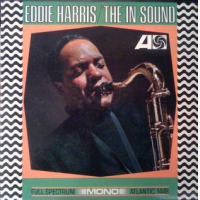 Eddie Harris
Eddie Harris The In Sound
1966
Best known for his experiments with electric tenor saxophones, which were regarded as gimmicks rather than legitimate experiments by the jazz establishment of the mid 1960s, Eddie Harris' formidable chops were beyond dispute. The In Sound is one of his landmark albums and was made with a quintet comprising trumpeter Ray Codrington, pianist Cedar Walton, bassist Ron Carter and drummer Billy Higgins. The set list is diverse, ranging from George Gershwin's "'S Wonderful" through Johnny Mandel's "Love Theme From The Sandpiper" and on to Harris' own "Freedom Jazz Dance," which would be immortalised by Miles Davis later in 1966 on Miles Smiles (Columbia).
 Roy Ayers
Roy Ayers Virgo Vibes
1967
Before he hit the dancefloor with Ubiquity in the 1970s, Roy Ayers was a straight-arrow post-bop vibraphonist. The band on Virgo Vibes includes trumpeter Charles Tolliver and alternating tenor saxophonists Joe Henderson and Harold Land. Herbie Hancock is the pianist on three tracks. Recorded in Los Angeles, where Tolliver was working with Gerald Wilson, the all original material includes Tolliver's "The Ringer" and Wilson's "In The Limelight." Ayers' next Atlantic album, Stoned Soul Picnic (1968), again with Tolliver and Hancock, plus alto saxophonist Gary Bartz, edges closer to funk and is almost as good. Both discs were produced by Herbie Mann.
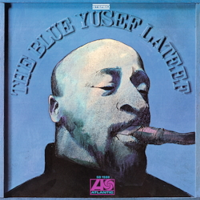 Yusef Lateef
Yusef Lateef The Blue Yusef Lateef
1968
The second of ten soul-jazz albums Yusef Lateef released on Atlantic between 1968 and 1976, all made with rock and R&B producer Joel Dorn. Most of the albums were stonkingly good but the series was controversial. Some of Lateef's existing followers hated the backbeats and bass ostinatos and, on The Blue Yusef Lateef, the inclusion of vocal group the Sweet Inspirations (featuring Cissy Houston, shortly before she went solo). Lateef adds the Indian tambura and Japanese koto to his repertoire. The drummer is the magnificent Roy Brooks (whose 1972 Muse album, The Free Slave, is a first-wave spiritual-jazz classic). The final album in the Lateef / Dorn series, The Doctor Is In...And Out (1976), is also recommended—even if the sleeve art is a bare-faced steal of Eric Dolphy's Out To Lunch! (Blue Note, 1964).
 Herbie Mann
Herbie Mann Memphis Underground
1969
Charles Lloyd and Yusef Lateef were Atlantic's most successful Haight Ashbury-targeted crossover artists during the late 1960s, but flautist Herbie Mann made a credible foray towards the demographic with Memphis Underground. Mann leads a lineup which includes three singular guitarists—Sonny Sharrock, Larry Coryell and Reggie Young—plus Roy Ayers. The title refers to Memphis' American Sound Studio, best known for hosting R&B artists , where the album was recorded with moonlighting members of the Muscle Shoals Rhythm Section. Tracks include the Sam & Dave hit "Hold On, I'm Coming" and the Aretha Franklin hit "Chain Of Fools." Miroslav Vitous plays bass on "Hold On, I'm Coming."
 Shirley Scott
Shirley Scott Shirley Scott & The Soul Saxophones
1969
Most of organist Shirley Scott's several dozen albums on Prestige and Impulse! were made with a tenor saxophonist, most notably Eddie Lockjaw Davis or Scott's husband, Stanley Turrentine. Her music was drenched in blues and soul, so this set with three similarly inclined saxophonists—altoist Hank Crawford and tenor players King Curtis and David Fathead Newman—was an A&R no-brainer. Tracks include Carole King's "(You Make Me Feel Like) A Natural Woman," the Isley Brothers' "It's Your Thing" and John Lennon and Paul McCartney's "Get Back." A deep-fried delight.
 Joe Zawinul
Joe Zawinul Zawinul
1971
In 1966, Joe Zawinul released his first Atlantic album, Money In The Pocket, a hard bop affair with tenor saxophonist Joe Henderson and trumpeter Blue Mitchell. It is a fine set but contains no hint of the revolutionary structural and sonic changes that were to come. By autumn 1970, when Zawinul was recorded, Zawinul was committed to an experimentalist path. He had passed through Miles Davis' electric band, having been part of In A Silent Way (Columbia, 1969) and Bitches Brew (Columbia, 1970), and was in the process of forming Weather Report. From the Davis band, Herbie Hancock is on second electric piano, Wayne Shorter is on soprano saxophone and drummer Jack DeJohnette appears on two tracks. From the first edition of Weather Report, Zawinul and Shorter are joined by bassist Miroslav Vitous. Tracks include a compelling treatment of Zawinul's "In A Silent Way," arranged as he had originally conceived it.
 Randy Weston
Randy Weston African Cookbook
1971
African Cookbook is a rerelease of pianist Randy Weston's Randy! (Bap!! Beep Boo-Bee Bap Beep-M-Boo Bee Bap!) . It was recorded in 1964 and Weston first put it out on his label, Bakton, in 1966. The band, a sextet, includes Booker Ervin on tenor saxophone and Ray Copeland on trumpet and flugelhorn. Six of the seven tunes are Weston originals, arranged by Copeland. Drummer Lenny McBrowne is joined by percussionists Big Black and Harold Murray on four tracks. The music emphasises Weston's already Africentric aesthetic. Weston revisited the title track several times, perhaps most magically on The Spirits Of Our Ancestors (Verve, 1992), where it was arranged by his longtime collaborator, trombonist Melba Liston.
 Von Freeman
Von Freeman Doin' It Right Now
1972
Von Freeman's feisty tenor saxophone was a mainstay of the Chicago club scene starting in the early 1950s, when he led an R&B band (briefly including pianist Ahmad Jamal) at the Pershing Ballroom and also gigged with Sun Ra. Freeman was just three months shy of his fiftieth birthday when he was "discovered" by Atlantic and recorded Doin' It Right Now. The album was produced by Roland Kirk. It is at least as good as Young And Foolish (Daybreak, 1981), which is sometimes put forward as Freeman's best. M-Base co-founder, alto saxophonist Steve Coleman, who lived in Chicago in the 1970s and attended many Freeman gigs, said in a 2019 interview that Doin' It Right Now was one of a handful of albums that changed his life.
Photo: Joe Zawinul.
Tags
PREVIOUS / NEXT
Support All About Jazz
 All About Jazz has been a pillar of jazz since 1995, championing it as an art form and, more importantly, supporting the musicians who make it. Our enduring commitment has made "AAJ" one of the most culturally important websites of its kind, read by hundreds of thousands of fans, musicians and industry figures every month.
All About Jazz has been a pillar of jazz since 1995, championing it as an art form and, more importantly, supporting the musicians who make it. Our enduring commitment has made "AAJ" one of the most culturally important websites of its kind, read by hundreds of thousands of fans, musicians and industry figures every month.









